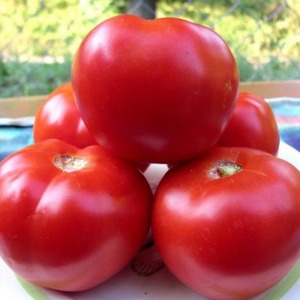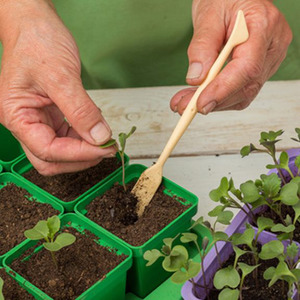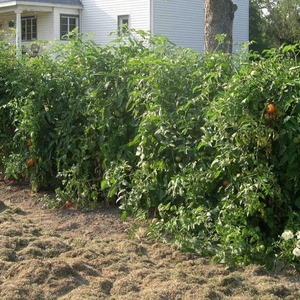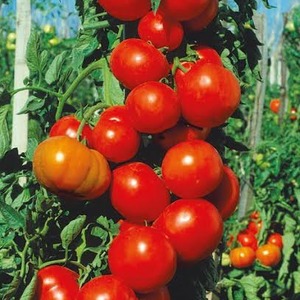High yield at minimal cost - tomato "Spasskaya Tower f1": reviews of gardeners and secrets of growing
In 2015, the selection collection of hybrids was replenished with another unique tomato "Spasskaya Tower f1". Meet a high-yielding, disease-resistant, unpretentious cultivar that is well adapted to the vagaries of the weather. Despite its short period of existence, the tomato has established itself only on the positive side, which makes it a welcome guest on any garden beds.
The content of the article
Characteristics and description of the variety
The originator of the Spasskaya Tower tomato is the Chelyabinsk Breeding Station. Vegetable seeds are sold by the large agricultural firm "Mars" under the trademark "Uralsky Dachnik".
Semi-determinant bush, height up to 1 m, grows up to 1.5 m in a greenhouse. The stem is strong, the leaves are bright green, of medium size. Up to 10 fruit-bearing clusters are formed on one plant, each cluster ties 4-6 fruits.
An early ripe hybrid, from the moment of emergence to full maturation, it takes 95-110 days. There is an increased resistance to changes in weather conditions.
Main characteristics:
- it is highly resistant to diseases of the nightshade family: cladosporium, fusarium. Recommended for cultivation in open ground and in greenhouse conditions;
- the yield is high, from 1 sq. m you can get up to 25 kg of fruit;
- culture requires obligatory garter and pinching;
- fruits are large, weight up to 0.5 kg, round shape, bright red color, dense skin;
- universal use in cooking: suitable both for fresh consumption and for preservation, pickling, pickles. Used for making ketchups, sauces, adjika, lecho;

- subject to long-term storage and transportation over long distances. These factors make the variety profitable to grow for sales.
In the photo there are tomatoes Spasskaya Tower f1.
How to grow seedlings
Sowing seeds begins 2 months before planting seedlings in open ground.
The soil mixture is prepared from peat, humus and garden soil in equal proportions. For 1 bucket of the mixture, add 1 teaspoon of superphosphate, potassium sulfate and urea. The prepared soil is disinfected with boiling water, poured into planting containers and moistened 1 day before sowing.
You can plant both in a common container and in individual containers. For the convenience of subsequent transplantation into the ground, peat pots are used. They are convenient in that you do not need to transplant seedlings from them, they are buried in the beds along with the sprouts. Subsequently, the peat pots dissolve in the ground without harming the root system.
Seed preparation before sowing is as follows:
- Soaking in a solution of liquid fertilizer, for example, Agricola-Vegata for 1 day at an air temperature of 25 C. Before placing the grains in the solution, they are wrapped in gauze or cloth.
- Hardening the grains for 2 days in the refrigerator, after soaking in the solution. A container with swollen grains is wrapped in cellophane and left in the refrigerator on the bottom shelf. This will make them strong, which will help in further full-fledged growth and development.
The seeds are placed in the prepared soil to a depth of 1 cm with a distance of 2 cm between them. The distance between the rows is at least 5 cm. After sowing, the ground is leveled from above and the containers are covered with film or glass. The room where the landing containers are left must be light and warm, the air temperature is at least 24 C.
When seedlings appear, the film is removed. Seedlings need full lighting. If daylight hours are not enough, they are illuminated with ordinary lamps. At the same time, the temperature in the room is reduced to 18 C, and the sprouts remain in this temperature regime for 5 days. Then the temperature is increased to 23 C.
When two true leaves appear, the seedlings dive, seating them in separate containers.
The photo shows the picking of seedlings:

Water the seedlings as the top layer of the soil dries up. The sprouts are not poured with water, but with a teaspoon they gently distribute warm, settled water along the edges of the nursery.
After watering, the ground must be loosened with an ordinary fork or wooden stick.
After a month, the seedlings are transplanted into a more spacious container. for the full development of the root system.
2 weeks before planting seedlings in open ground, they begin to harden them. The hardening procedure is reduced to the fact that the bushes stay outside for 2 - 3 hours. At night, in the room where the seedlings are located, the temperature is reduced to 13 C. The time spent outdoors gradually increases to 18 hours.
How to grow tomatoes
After 2 months, the seedlings are ready to be transplanted to a permanent place.
Beds for tomatoes are chosen in a sunny place protected from drafts. Planting pattern: 50 cm - distance between seedlings, 50 cm - between rows. For 1 sq. m place no more than 4 seedlings.
Tomatoes are planted in pre-prepared holes, 15 cm deep, in a checkerboard pattern. This method of planting gives additional advantages: the plants not only do not interfere with each other's growth, but also receive enough light and are well ventilated. Seedlings will take root faster in a new place if they are transplanted on a cloudy day or in the evening.
Before planting, a humate solution is introduced into the holes and 1 liter of water is poured into each... It is undesirable to make fresh manure for tomatoes, as it contributes to the development of green mass, while the fruits are formed small due to insufficient nutrients.
After planting, the bushes are moderately watered warm, settled water, strictly at the root. After the earth is loosened, hilled and mulch... Loosening promotes better oxygen penetration to the roots, and mulching retains moisture in the beds longer.
reference! In order for the seedlings to take root in the open field faster, they are covered with non-woven material.
The next watering is in a week, with water preheated in the sun. Further watering - as the soil dries up, but not more often than twice a week. The culture responds well to drip irrigation. In hot weather, the frequency of watering is increased to four per week. It is also often watered while pouring the fruit.
The first feeding is carried out when on the lower branch the tomatoes reach the size of a nut. They are fed with a complete mineral fertilizer with a complex of microelements (35 g for 1 bucket of water) or organic matter.
Poultry droppings are suitable as organic matter, diluted in a ratio of 1 kg to 1 bucket of water. From this period, 10 g of potassium sulfate is added to each top dressing. Further feeding is carried out once every 14 days with the same solution, adding 1 teaspoon of humate to a bucket.
Due to the high growth, the garter of the plants is required. Moreover, not only the stem is tied up, but also the fruiting brushes, otherwise they will not withstand the weight of ripe vegetables.
For a high rate of fruiting, the Spasskaya Tower tomato needs proper pinching. This procedure is carried out regularly, leaving only one shoot under the first flower brush, since the plant is led into 2 trunks. It is necessary to take stepson once a week.
Diseases and pests
The tomato culture is rarely attacked by insects and various infections. The only danger is late blight, a fungal disease, the prevention of which is the control of moisture in the beds. Waterlogged beds promote rotting of the lower leaves of plants, which forms a favorable environment for any fungal disease.
Experienced gardeners immediately after transplanting seedlings spray it with copper chloride (30 g per 10 l of water), which not only helps in growth and development, but also increases the immunity of seedlings.
For the treatment of late blight use systemic fungicides, for example, the drug "Hom" or "Fitosporin". If the disease is at an early stage, copper sulfate will help, which is also suitable as a prophylaxis.
Among insect parasites, whitefly and spider mites can cause harm. The spider mite lives in greenhouses. To destroy it, it is enough to ventilate closed structures every day. It will destroy the usual habitat pest.
The whitefly butterfly harms plants in open beds. Pungent-smelling herbs such as marigold and calendula will help fight it. Arrows of onions and garlic also help well. Plants can be sprayed with a decoction of onion husks without harming the developing fruits.
The nuances of growing in open ground and in a greenhouse
The variety is recommended for growing in open ground and in greenhouse conditions.
Subject to the rules of agricultural technology and crop rotation, the harvest is obtained within six months in the open field, and in greenhouses - all year round. Due to the high adaptation to weather whims, sudden frosts do not affect the quantitative indicator of fruiting.
The unusual structure of the bush helps the plant to grow and develop fully. Half of the knots do not form stepchildren, so the tomato gets enough light and is regularly ventilated.
In the open field plays an important role correct culture garter... They begin to tie up very young bushes, two weeks after transplantation. This allows the stem to form even and firm. A garter of branches is also required.
In the greenhouse, the height of the seedlings is higher than in the open field. This means that they have more fruitful clusters, which increases the number of ripe vegetables.
Airing your greenhouse regularly will help keep your plants healthy all year round. But do not forget that the tomato is afraid of drafts.
Harvesting and application of the crop
Thanks to the garter, picking ripe vegetables is easy. Maturing amicably, with whole brushes. The first vegetables ripen in July.
A record amount of ripe vegetables can be obtained only in a greenhouse, here from 1 sq. m collect up to 25-30 kg.
The use of tomato is universal. It is equally good for fresh consumption and for preservation. It makes excellent summer salads, hot and vegetable dishes. Does not lose its taste in marinades and pickles. It is used for the preparation of tomato products: lecho, pasta, juice, adjika, sauces, ketchup.
It is subject to long-term storage and can withstand long-term transportation. The variety is widely used commercially as it retains its appearance perfectly without losing taste.
Advantages and disadvantages
The hybrid has many advantages that make it more and more popular among vegetable growers:
- high adaptation to climatic features;
- early ripening variety;
- high rate of fruiting;
- unpretentious care;
- disease resistance;
- survival rate in all regions;
- the possibility of year-round breeding in a greenhouse;
- great taste of ripe vegetables;
- marketable condition;
- long storage;
- long transportation;
- the possibility of using for commercial purposes.
Some disadvantages of this kind:
- poor development of the root system;
- regular pinching is required;
- garter required;
- the inability to independently prepare seed material.
Farmers reviews
Review of tomato reviews Spasskaya Tower speaks of the high quality of the hybrid.
Marina, Moscow region:
“The hybrid is wonderful. It does not require a lot of time and effort, and the return is incredible. The vegetables are tasty, well stored, suitable for any kind of dishes and preparations. The yield is stable. "
Valery, Rostov region:
“I have been growing tomato in an industrial greenhouse for two years now.I'm happy with the result. Plants are tall, but well ventilated. I mechanize the collection of vegetables, they do not crack and are well transported. "
Conclusion
Many gardeners want to grow tall varieties of tomatoes because of the impressive numbers. But, as a rule, they require difficult maintenance.
The Spasskaya Tower hybrid is distinguished by the fact that it gives a large harvest with a minimum investment of time and effort. At the same time, it is disease-resistant, adapted to any climate and is excellent for commercial breeding, fully reimbursing the initial costs.